Fish
The World’s Ten Largest Eels, According To Their Length And Sizes!
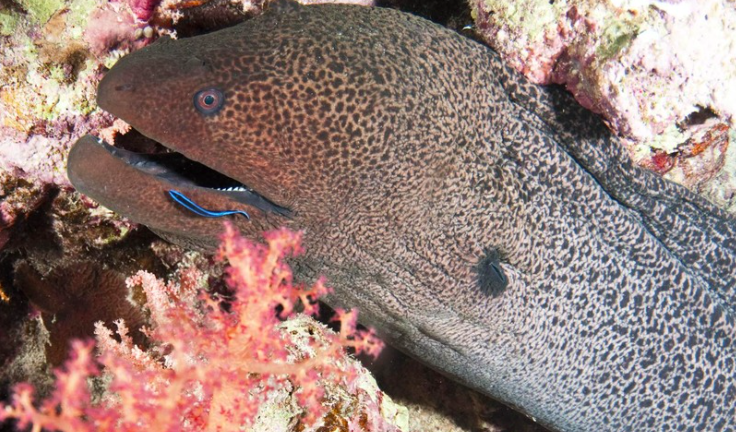
The World’s Ten Largest Eels, According To Their Length And Sizes.
Eels initially appeared on the planet more than 65 million years ago, and they are still alive and well now. There are approximately 800 different species of eel found worldwide, and the majority of them are in good condition.
Regardless of whether they reside in fresh or saltwater, these ray-finned fish find a method to assert their dominance over their environment. It’s not difficult to envisage these mysterious creatures as strong sea monsters, given that they’re part fish, part snake, and have jaws full of razor-sharp teeth to match.
Despite their intimidating look, eels serve an important part in the health of marine ecosystems. This kind of nocturnal predator preys on everything from fish to crabs to other eels because it has almost no natural predators.
Some species could live for up to 20 years and grow to huge proportions. Even though they occur in various sizes and shapes, ranging from tiny dwarf eels to the massive moray, the largest species captures our attention.
These specimens have earned the eel the moniker “The Devil of the Sea” because of their enormous size and dimensions. In order to decide which eel species is the largest, you must compare both their length and weight, with weight being the most important factor to consider.
Meanwhile, some species, such as electric eels and wolf eels, are called eels; they are members of separate animal groups and are not true eels in the literal sense of the word. As a result, despite their enormous size, they do not rank among the world’s greatest eels. After considering all of this, here is a list of the top 10 largest eels on the planet.
10). Southern Conger Eel
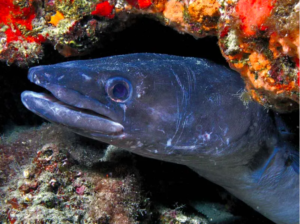
The southern conger (Conger verreauxi) is a family or member of the Congridae family and is found in the southern United States. The largest of them can grow to be 6.5 feet long and weigh up to 11 pounds at their full size.
Their elongated, brown-grey bodies have a similar appearance to the most common species of conger eel, but they are smaller. In the waters off the southern shores of Australia and New Zealand, they can be found regularly.
Typically, southern congers can be found in stony reef environments at depths of up to 330 feet. As opportunistic, nocturnal hunters, they will consume anything from fish to crustaceans and even other eels if the opportunity presents itself, even other eels.
Currently, they are classified as a species of Least Concern by the International Union for Conservation of Nature.
9). California Moray Eel
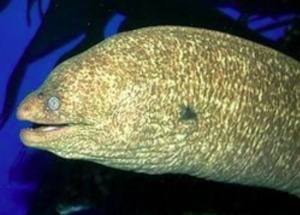
It was named because it is the only species of moray that can be found off the coast of California, hence earning it the name California moray. They could grow to be up to 5 feet long and weigh nearly 15 pounds at their heaviest when they are fully grown. They have a variety or lots of appearances, ranging from a mottled brown tint to almost green.
While the vast majority of morays are found in temperate waters, the California moray is one of the rare species that can be found in subtropical seas.
If you want to see one in the wild, look for bouldered areas around 120 feet below sea level, which is where they usually live. Their primary diet consists of fish, but they will also consume lobsters, shrimp, and octopuses if available.
Because they are not commercially fished and do not have any predators, the International Union for Conservation of Nature (IUCN) classifies them as a species of Least Concern.
8). American Eel
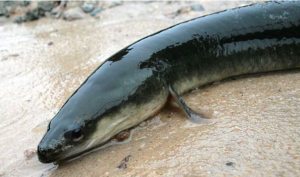
Anglerfish (Anguilla rostrata) are migratory fish that can be found off the shore of North America’s eastern seaboard. The largest specimens can grow to be around 4 feet long and weigh up to 17 pounds at their mature size.
They range from dark green with brown shading to light grey with white bellies, with darker green being the most common. Their bodies are covered in a thin layer of mucus, giving them a bare and slimy appearance.
American eels could spend most of their life in freshwater, only venturing into the ocean to reproduce once every few years.
Females could lay up to 4 million eggs in a single cycle. Creatures like crustaceans, insects, and whatever else they can locate to eat make up their diet.
Their populations have decreased drastically in recent years due to habitat loss caused by the construction of dams along migration routes. As a result, they are listed as an Endangered species by the International Union for Conservation of Nature.
7). Moray Eel With Fangtooth
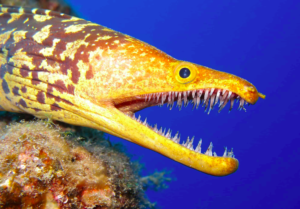
The fangtooth moray (Enchelycore anatina), sometimes known as the tiger moray or the bird-eye conger, is perhaps one of the most fearsome members of the moray family. It is also one of the most venomous. Their mouth is lined with huge, glass-like teeth, which gives them their name.
A single individual can grow to be up to 4 feet in length and weigh up to 30 pounds. Their look is highly noticeable because of the brilliant yellow-orange and brown colour on their bodies. Their warm-weather habitats are located in the Atlantic Ocean’s warm-water zones, such as the Mediterranean Sea, the Canary Islands, and Madeira.
Fangtooths are nocturnal hunters who live and hunt in the rocky crevices of the seafloor. Crustaceans, cephalopods, and bottom-feeding fish are the primary prey for these predators. The fangtooth moray is listed as a species of Least Concern by the International Union for Conservation of Nature.
6). Moray The Slender
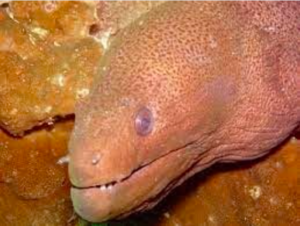
The slender giant moray (Strphidon sathete) is the world’s longest eel and is the longest eel on the planet. The slim gigantic moray puts the rest of the group to shame when it comes to eels, renowned for their elongated bodies.
The world’s largest specimen was discovered, which measured an astonishing 13 feet in length. Even though the specifics of their weight vary depending on their size, they could weigh up to approximately 40 pounds at their heaviest.
They are normally brownish-grey in hue, yet their colour becomes paler on their bellies as they get older. They could be found in all parts of the Indian and Pacific oceans, from the Red Sea to the western Pacific, and they are very slender.
Their favourite settings are typically muddy, allowing them to blend in with their surroundings. Their main hunting habitats include river estuaries and bays, among other places. Fish, crabs, and molluscs are among the foods they eat.
The reports of The International Union for Conservation of Nature (IUCN) classified enormous morays as a species of Least Concern. Nevertheless, no research has been conducted to determine the current state of slender gigantic morays.
5). Grey Conger
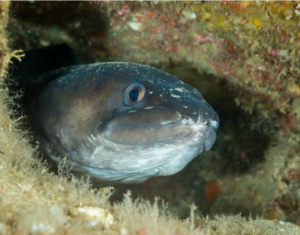
The grey conger (Conger esculentus), sometimes known as the Antillean conger, is a common member of the conger family that can be found around the world. They were given this name because of their sleek grey colouring, but their bellies are more white than grey in appearance.
While most examples are approximately 3 feet in length, they can grow to be 5.2 feet long and weigh nearly 55 pounds. Grey congers are found in maritime habitats that are tropical or subtropical in climate.
They can be found throughout the western central Atlantic Ocean, but they are most common around Cuba, Jamaica, and northern South America, among other places.
GREY CONGERS, which may live at depths of up to 1300 feet, are found on coral reefs and in rocky areas along the ocean floor. Finfish, as well as other bottom-feeding species, are the principal food supply for these creatures.
Even though there is a growing industry for grey conger flesh, the International Union for Conservation of Nature (IUCN) classifies them as a species of Least concern.
4). Green Moray Eel
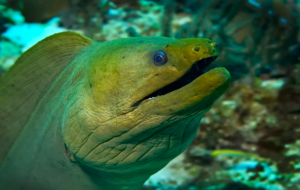
Gymnothorax funebris is a huge species of moray eel that is one of the largest in the moray eel family. Because of the vivid greenish-yellow colour that spans the length of their bodies, they were given this name.
Green morays are easily distinguished from yellow morays based merely on their size, although they are sometimes confused with the latter.They could grow up to 8 feet long and weigh approximately 65 lbs. Green morays can be found throughout the western Atlantic Ocean, from New Jersey to Bermuda and off the coast of Brazil and the Caribbean.
Depending on the species, they can be found in depths of up to 130 feet below sea level. They are nocturnal hunters, as are the majority of moray species. They primarily eat fish, crab, shrimp, octopuses, and squid, among other things.
According to the report of the International Union for Conservation of Nature, the green moray is a species of Least Concern.
3). Giant Moray Eel
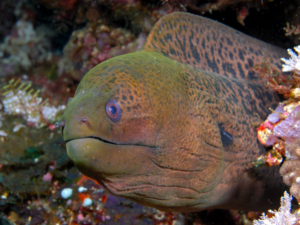
When measured in terms of body mass, the giant moray (Gymnothorax javanicus) is the largest moray eel on the planet. However, while the slim giant moray may be the world’s longest eel, the big moray is far larger and heavier than its skinny cousin.
They can grow to be 9.8 feet long and weigh 66 pounds at their heaviest when they reach their maximum size. Large tan spots cover their brownish bodies, and the backs of their heads have two leopard-like spots, which are particularly noticeable in adults.
Giant morays can be found throughout the Indian and Pacific Oceans, including the eastern coast of Africa, the Red Sea, the Hawaiian Islands, Polynesia, Fiji, and Japan, among other places. They can be found in lagoons and at the outer edges of coral reefs, where they thrive.
Their primary sources of nutrition are fish and crabs. Even though a few predators surround them, they will cooperate with other fish species, such as the roaming coral grouper, to look for food.
Even though they are not typically violent toward humans, they will attack if cornered or threatened. Currently, they are classified as a species of Least Concern by the International Union of Conservation of Nature.
2). American Conger
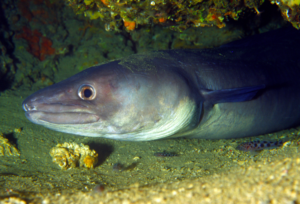
The American conger (Conger oceanicus), also known as the dog eel, poison eel, and sea eel, is one of the world’s largest eel species. While most examples are a little longer than 3 feet in length, they could grow to be 6.5 feet long and also weigh up to 88 pounds.
Their bodies are typically dark grey. However, their bellies are often pale in colour. From Cape Cod to northeastern Florida, American congers can be seen in large numbers in the western Atlantic Ocean.
Unlike certain eel species, they do not spend any time in freshwater during their lifetimes, even though they migrate. Although they like to reside on the ocean’s surface, you can locate them in shallow and deep water. They primarily eat fish, molluscs, and crustaceans as their primary sources of nutrition.
Even though they have no natural predators, there is little fishing business for American conger. Because their population is vast and abundant, the International Union for Conservation of Nature (IUCN) classifies them as a species of Least Concern.
1). European Conger
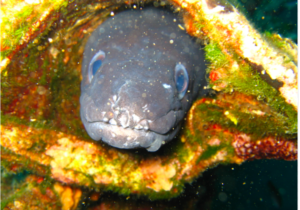
The European conger (Conger conger) is the world’s largest eel by far, with a length of almost two meters. Adults are approximately 5 feet 5 inches tall and weigh approximately 159 pounds.
On the other hand, one huge specimen was 9.8 feet in length and weighed 350 pounds. They have no scales covering their bodies, and although they are usually grey, they can sometimes be blackish.
They may pose a concern to divers because of their big size and aggressive attitude. Throughout Europe, congers can be found in the eastern Atlantic off the coasts of Norway and Iceland and the Mediterranean and the Black Sea.
While sightings normally occur between 0 and 1500 feet below the ocean’s surface, when migrating to spawning areas, they can descend to depths of up to 10,000 feet below the water’s surface. They reside in rocky outcroppings known as eel pits, and they will occasionally cohabitate with other eels if conditions are favourable.
Fish, octopuses, squid, and crustaceans make up most of their diet. Because of their widespread distribution and large population, the International Union for Conservation of Nature (IUCN) classifies these as a species of Least Concern.
Questions People Also Ask: (FAQs)
The top three largest eel species in the world by length and size are:
- Giant Moray Eel (Gymnothorax javanicus): This eel can reach lengths of up to 10 feet (3 meters) and weigh around 66 pounds (30 kg).
- Slender Giant Moray (Strophidon sathete): Known for its slender body, this eel can grow up to 13 feet (4 meters) in length.
- European Conger (Conger conger): The European conger is one of the heaviest eels, capable of growing up to 10 feet (3 meters) in length and weighing over 240 pounds (110 kg).
How do scientists measure the size of eels, and why is this important?
Scientists measure the size of eels by recording their length from the tip of the snout to the end of the tail, and by weighing them. This is important for several reasons:
- Understanding Growth Patterns: Tracking the size of eels helps scientists understand their growth rates and life stages.
- Conservation Efforts: Knowing the sizes of various eel species aids in monitoring their populations and implementing conservation measures.
- Ecological Impact: Larger eels often play significant roles in their ecosystems, and understanding their size helps in studying their ecological impact.
What unique features distinguish the Giant Moray Eel from other large eel species?
The Giant Moray Eel (Gymnothorax javanicus) is distinguished by several unique features:
- Coloration: It has a distinctive dark brown to black coloration with a mottled pattern that provides camouflage among coral reefs.
- Size: As one of the largest eels, it can grow up to 10 feet in length.
- Habitat: It is commonly found in the Indo-Pacific region, residing in coral reefs and rocky crevices.
- Diet: It has a varied diet, including fish, crustaceans, and cephalopods, and is known for its powerful jaws and sharp teeth.
Why are European Conger eels considered one of the heaviest eel species, and where are they typically found?
European Conger eels (Conger conger) are considered one of the heaviest eel species due to their robust body structure and ability to reach significant weights, sometimes exceeding 240 pounds. They are typically found in the eastern Atlantic Ocean, including the Mediterranean and Black Seas. These eels prefer rocky coastal areas, caves, and shipwrecks, where they hunt for fish, crustaceans, and cephalopods.
What conservation challenges do the world’s largest eels face, and what measures are being taken to protect them?
The world’s largest eels face several conservation challenges, including:
- Overfishing: Many large eel species are targeted for their meat and skin, leading to population declines.
- Habitat Loss: Coastal development, pollution, and destruction of coral reefs threaten their natural habitats.
- Climate Change: Rising ocean temperatures and acidification impact their breeding and feeding grounds.
- Illegal Trade: Some eel species are subject to illegal trade, particularly in the seafood market.
Conservation Measures:
- Protected Areas: Establishing marine protected areas to safeguard critical habitats.
- Fishing Regulations: Implementing size and catch limits to prevent overfishing.
- Research and Monitoring: Conducting scientific research to monitor populations and understand their ecology.
- Public Awareness: Raising awareness about the importance of eel conservation and promoting sustainable practices.
These efforts aim to ensure the survival of these fascinating creatures and maintain the balance of marine ecosystems.
We appreciate you for taking the time to read!
Finally, we hope you found this article interesting? And what do you think about ”The World’s Ten Largest Eels, According To Their Length And Sizes!?”
Please you should get in touch with us if you want to contribute to this article or advertise.
And let us know if you observe something that isn’t quite right.
Fish
Unlocking the Secrets of Goldfish Longevity: How Long Do Goldfish Live?
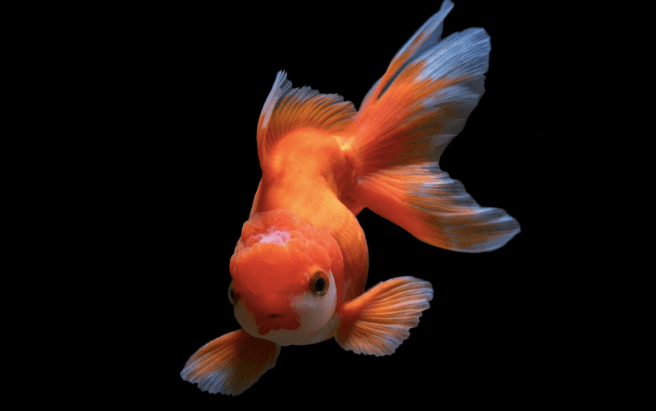
Unlocking the Secrets of Goldfish Longevity: How Long Do Goldfish Live?
Goldfish are one of the most popular and beloved pets around the world. With their vibrant colors and graceful swimming, they bring beauty and tranquility to any home or office aquarium.
But have you ever wondered how long these fascinating creatures can live?
In this article, we will explore the lifespan of goldfish and provide you with valuable insights to help you care for your aquatic companions.
Factors Affecting Goldfish Lifespan
The lifespan of goldfish can vary significantly depending on several factors. While some goldfish may live for only a few years, others have been known to live for several decades. Here are the key factors that influence the lifespan of goldfish:
1. Genetics
Just like humans, the genetic makeup of goldfish plays a crucial role in determining their lifespan. Some goldfish breeds are naturally hardier and have a longer lifespan, while others may be more prone to genetic health issues that can shorten their life expectancy.
2. Water Quality
Providing a clean and well-maintained environment is essential for the health and longevity of goldfish. Poor water quality, such as high levels of toxins or inadequate oxygenation, can significantly impact their lifespan. Regular water changes and proper filtration systems are crucial to ensure optimal water conditions.
3. Diet and Nutrition
A balanced and nutritious diet is vital for the overall health of goldfish. Feeding them a variety of high-quality commercial fish food, supplemented with occasional treats like vegetables or live food, can help support their immune system and promote a longer lifespan.
4. Tank Size and Environment
The size of the tank and the overall living environment have a direct impact on the well-being of goldfish. Providing enough space for them to swim and grow is essential. Overcrowding can lead to stress, poor water quality, and increased susceptibility to diseases, ultimately shortening their lifespan.
Average Lifespan of Goldfish
On average, goldfish can live anywhere between 10 to 15 years. However, with proper care and optimal conditions, some goldfish have been known to live up to 20 years or even longer. It’s important to note that the lifespan of goldfish can vary depending on the factors mentioned above.
Longevity Records of Goldfish
While the average lifespan of goldfish is around 10 to 15 years, there have been exceptional cases of goldfish living much longer. Here are a few notable records:
1. Tish, the Goldfish
Tish, a goldfish from the United Kingdom, held the record for the longest-lived goldfish. She lived for an impressive 43 years before passing away in 1999. Tish’s longevity was attributed to her owner’s meticulous care and a healthy environment.
2. Goldie, the Carassius auratus
Goldie, a goldfish from Australia, made headlines when she celebrated her 45th birthday in 2005. Her owner, who had inherited her from his grandmother, ensured she received excellent care and a spacious tank to thrive.
3. Fred, the Goldfish
Fred, a goldfish from the United States, lived for an astounding 41 years. His owner diligently maintained his tank, providing him with a balanced diet and a stress-free environment.
Tips for Extending Your Goldfish’s Lifespan
If you want your goldfish to live a long and healthy life, here are a few tips to keep in mind:
- Provide a spacious tank with ample room for swimming.
- Maintain clean water by performing regular water changes.
- Invest in a reliable filtration system to keep the water properly oxygenated.
- Feed your goldfish a balanced diet of high-quality fish food.
- Avoid overfeeding, as it can lead to obesity and health issues.
- Monitor the water temperature to ensure it remains within the recommended range for goldfish.
- Keep an eye out for any signs of illness or distress and seek veterinary care if needed.
By following these guidelines and providing your goldfish with the care they need, you can help ensure they live a long and fulfilling life.
Conclusion
Goldfish are captivating creatures that bring joy and serenity to their owners. With proper care and attention to their needs, goldfish can live for many years, becoming cherished members of the family.
Remember to consider the genetic factors, water quality, diet, and tank size when caring for your goldfish. By providing them with a healthy and nurturing environment, you can maximize their lifespan and create a thriving aquatic habitat.
We appreciate you for taking the time to read this article!
Finally, we hope you found this article interesting? And what do you think about ”Unlocking the Secrets of Goldfish Longevity: How Long Do Goldfish Live?!?”
Please feel free to share or inform your friends about this article and this site, thanks!
And let us know if you observe something that isn’t quite right.
Fish
Unlocking the Secrets to Goldfish Longevity: A Comprehensive Guide
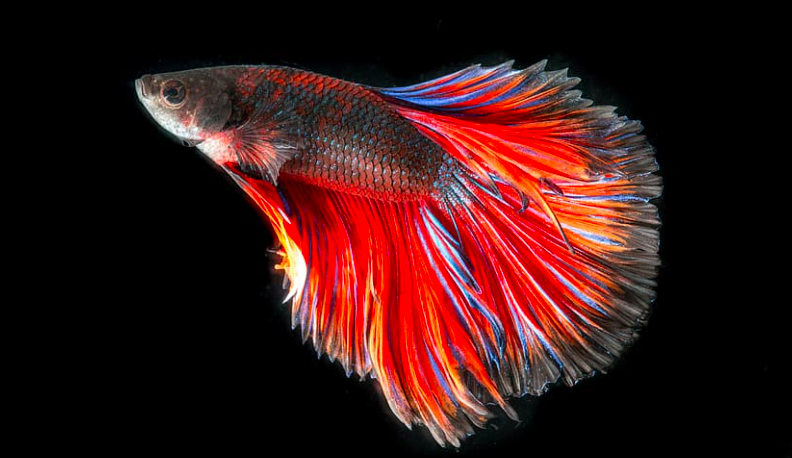
Unlocking the Secrets to Goldfish Longevity: A Comprehensive Guide
Goldfish enthusiasts, buckle up! Today, we dive deep into the fascinating world of goldfish longevity, uncovering the secrets to ensuring your aquatic companions live their happiest, healthiest, and longest lives.
Whether you’re a seasoned goldfish aficionado or a newbie to the aquatic realm, this guide will equip you with the knowledge to keep your underwater friends thriving.
Understanding the Basics: What Influences Goldfish Longevity
Goldfish, those shimmering aquatic companions adorning our homes, bring a touch of serenity to our lives. However, ensuring the longevity of these mesmerizing creatures goes beyond just feeding them regularly.

In this deep dive into the world of goldfish care, we unravel the essential factors that influence their longevity.
1. Choosing the Right Environment
Creating a conducive habitat for your goldfish is paramount. Start with an adequately sized aquarium, allowing at least 20 gallons per fish.
Proper filtration is equally crucial, maintaining water quality and reducing stress. Remember, a stress-free goldfish is a healthy goldfish.
2. Water Quality Matters
The phrase “as happy as a fish in water” holds true only when the water quality is optimal. Regular water changes, maintaining appropriate pH levels, and investing in a reliable water testing kit are indispensable practices.
These actions contribute significantly to the overall well-being and longevity of your goldfish.
3. Nutritious Diet for Longevity
Just like any pet, a goldfish’s diet plays a pivotal role in its overall health and longevity. Provide a well-balanced diet that includes high-quality flakes, pellets, and occasional treats like live or frozen brine shrimp. Avoid overfeeding, as it can lead to health complications.
4. Adequate Space for Growth
Goldfish have the potential for substantial growth. Stunting, a common issue, occurs when they are kept in cramped environments. Ensure your goldfish have enough space to grow naturally, promoting a healthier and longer life.
5. Companionship and Tank Mates
Goldfish are social creatures, and companionship can positively impact their mental well-being. However, not all fish make suitable tank mates. Research and carefully choose compatible species to avoid stress and potential conflicts.
6. Regular Health Check-ups
Prevention is better than cure, even in the underwater world. Conduct regular health check-ups, examining your goldfish for signs of illness. Promptly address any issues to prevent the spread of diseases, ensuring a longer and happier life.
7. Temperature Control
Maintaining a stable water temperature is crucial for goldfish longevity. Fluctuations in temperature can lead to stress and susceptibility to diseases. Invest in a reliable aquarium heater and monitor the temperature consistently.
8. Genetics and Breeding
The genetic makeup of your goldfish plays a vital role in determining its lifespan. Opt for reputable breeders to ensure healthier genetics. Moreover, responsible breeding practices contribute to the overall well-being of goldfish populations.
9. Environmental Enrichment
Goldfish, despite their calm demeanor, benefit from environmental enrichment. Incorporate decorations, plants, and hiding spots in the aquarium. This not only adds aesthetic value but also provides mental stimulation for your aquatic friends.
10. Regular Observations and Interaction
Understanding your goldfish requires regular observations. Take time to interact with your aquatic companions, learning their behavior patterns. Early detection of any deviations from normal behavior can be instrumental in preventing potential health issues.
Common Mistakes to Avoid: Pitfalls in Goldfish Care
Embarking on the journey of goldfish care is a rewarding experience, but pitfalls lurk along the way. To ensure the well-being and longevity of your aquatic companions, let’s delve into the common mistakes that many unwitting enthusiasts often make.

1. Overcrowded Tanks: The Space Conundrum
One prevalent mistake is underestimating the space goldfish require. Overcrowded tanks lead to stress, stunted growth, and increased vulnerability to diseases. Ensure your goldfish have ample space to swim and grow by following appropriate stocking guidelines.
2. Neglecting Water Quality: A Silent Menace
Perhaps the most critical factor in goldfish care is water quality. Neglecting regular water changes, failing to monitor pH levels, and overlooking filtration systems can result in poor water quality. This, in turn, jeopardizes the health and longevity of your goldfish.
3. Inappropriate Tank Mates: The Compatibility Quandary
While companionship is beneficial, selecting incompatible tank mates can lead to aggression, stress, and even injury. Research thoroughly to identify suitable tank mates, considering size, temperament, and environmental preferences.
4. Overfeeding Woes: Too Much of a Good Thing
The adage “less is more” holds true in goldfish feeding. Overfeeding not only pollutes the water but also contributes to health issues like swim bladder disorder. Follow a balanced feeding schedule and avoid the temptation to shower your goldfish with excessive treats.
5. Inconsistent Temperature Control: The Rollercoaster Effect
Goldfish thrive in stable environments. Fluctuating temperatures can stress your aquatic friends and make them susceptible to diseases. Invest in a reliable aquarium heater and maintain a consistent water temperature within the recommended range.
6. Lack of Observation: Ignoring Behavioral Cues
Neglecting to observe your goldfish regularly can result in late detection of health issues. Changes in behavior, appetite, or swimming patterns may indicate underlying problems. Stay vigilant and address any deviations promptly.
7. Poor Diet Choices: Nutritional Neglect
Goldfish need a well-balanced diet for optimal health. Relying solely on one type of food or feeding inappropriate treats can lead to nutritional deficiencies. Consult with experts or veterinarians to create a nutritionally balanced diet for your goldfish.
8. Overlooking Tank Maintenance: The Dirty Dilemma
A clean tank is a happy tank. Neglecting regular maintenance tasks such as cleaning filters, removing debris, and scrubbing algae can compromise water quality and create an unhealthy environment for your goldfish.
9. Ignoring Genetic Factors: The Breeder’s Impact
Choosing a goldfish from a reputable breeder is crucial. Poor breeding practices can result in genetic predispositions to illnesses and shorter lifespans. Research breeders and opt for those known for responsible breeding.
10. Skipping Quarantine: A Preventive Measure
Introducing new fish without quarantine can introduce diseases into your aquarium. Always quarantine new additions to monitor their health before introducing them to the main tank, preventing potential outbreaks.
Health Check: Identifying and Addressing Goldfish Ailments
Goldfish, with their dazzling scales and captivating swim, are delightful pets. However, even the most dedicated owners can encounter health challenges.
In this guide, we delve into the art of identifying and addressing common goldfish ailments to ensure your finned friends lead long and healthy lives.
1. Recognizing Signs of Illness
Understanding your goldfish’s normal behavior is the first step in identifying health issues. Watch for changes in appetite, swimming patterns, coloration, and the appearance of fins or scales. Any deviations from the norm may be indicative of an underlying problem.
2. Common Goldfish Ailments
a. Ich (White Spot Disease): This prevalent parasite manifests as small white dots on the skin, fins, and gills. Quarantine affected fish, gradually raise the water temperature, and treat with a suitable medication.
b. Fin Rot: Recognized by ragged fins or tail, fin rot is often caused by poor water quality. Improve water conditions, remove any decaying matter, and administer antibiotic treatments as necessary.
c. Swim Bladder Disorder: Affecting buoyancy, swim bladder issues result in floating or sinking. Adjust feeding habits, offer a diet with more fiber, and consider a temporary fasting period.
d. Dropsy: Characterized by swollen body and scales, dropsy indicates internal organ failure. Isolate the affected fish, enhance water quality, and consult a vet for antibiotics.
3. Proactive Measures for Preventing Illness
a. Maintain Water Quality: Regular water changes, proper filtration, and monitoring water parameters are fundamental in preventing a myriad of health issues.
b. Quarantine New Additions: Before introducing new fish to your aquarium, quarantine them to prevent the spread of potential diseases.
c. Balanced Diet: Provide a varied and nutritious diet to boost the immune system. Avoid overfeeding, as it can lead to digestive problems.
d. Adequate Space: Avoid overcrowding in the tank, as it can stress fish and contribute to the spread of diseases.
4. Consulting a Vet: When and Why?
Knowing when to seek professional help is crucial. If home remedies prove ineffective or if the condition worsens, consult a vet experienced in aquatic animal care. Early intervention can make a significant difference in your goldfish’s recovery.
5. Isolation and Medication
When you notice signs of illness, promptly isolate the affected fish to prevent the spread of diseases. Follow the recommended dosage of medications, and complete the treatment course even if the fish appears to recover sooner.
6. Stress Management
Goldfish are sensitive to changes in their environment. Minimize stress by maintaining a stable environment, avoiding sudden changes, and providing adequate hiding spots.
Conclusion: Nurturing the Fountain of Youth for Goldfish
In the delicate dance of goldfish care, the key to unlocking the fountain of youth lies in our hands. By avoiding common pitfalls, embracing proper nutrition, and crafting a haven of harmony, we bestow upon our aquatic companions the gift of vitality.
As custodians of their underwater world, our choices ripple through their scales, shaping a narrative of joy, longevity, and the timeless beauty found in a well-tended aquarium.
Here’s to the enduring health and happiness of our finned friends, and the shared moments that unfold within the watery embrace of their home.
Frequently Asked Questions (FAQs)
Can goldfish live in bowls?
Goldfish need ample space to thrive. Bowls are too small and lack proper filtration, leading to poor water conditions and health issues. Opt for a spacious tank instead.
How often should I feed my goldfish?
Feed your goldfish small, regular meals 2-3 times a day. Monitor their consumption and adjust accordingly to prevent overfeeding.
Are goldfish hardy pets?
While goldfish are hardy, they require proper care. Neglecting their needs can result in health issues. With the right care, they make resilient and long-lived companions.
Do goldfish get bored?
Yes, goldfish can get bored. Introduce toys, mirrors, and novel elements to their environment to keep them mentally stimulated.
Can I keep different goldfish breeds together?
Compatibility is crucial. Research the specific needs and temperaments of different goldfish breeds before introducing them to the same tank.
Embrace these insights, and you’ll be well on your way to unlocking the secret to goldfish longevity. Your aquatic friends will thank you with a lifetime of joy and vibrant underwater adventures.
Note: This article is not intended as veterinary advice. Consult with a qualified professional for specific concerns regarding your goldfish’s health.
We appreciate you for taking the time to read this article!
Finally, we hope you found this article interesting? And what do you think about ”Unlocking the Secrets to Goldfish Longevity: A Comprehensive Guide!?”
Please feel free to share or inform your friends about this article and this site, thanks!
And let us know if you observe something that isn’t quite right.
Fish
Best Tank Mates for Betta Fish: A Beginner’s Guide

Curating a harmonious aquarium for your betta fish involves choosing compatible tank mates that ensure a tranquil environment.
Bettas, with their flamboyant fins and solitary nature, require companions that respect their space and don’t compete for dominance. This beginner’s guide highlights the best tank mates that align with the betta’s need for peace and stability.
By selecting the right fish, you’ll not only enhance your betta’s wellbeing but also foster a vibrant and diverse aquatic ecosystem.
Remember, keeping a well-balanced tank is not just about aesthetics, it’s crucial for maintaining the health and happiness of all your finned friends.
Understanding Betta Fish Behavior
As a beginner, understanding the unique personality of your finned friend is critical to choosing the perfect tank mates. Let’s delve into the behavior of betta fish to set the stage for a peaceful aquarium environment.
Territorial Nature Of Betta Fish
Betta fish, also known as Siamese fighting fish, are renown for their territorial instincts. These fish often guard their space fiercely against intruders. Recognizing this trait is key. It helps prevent unwelcome confrontations in your tank.
- Males are particularly territorial.
- Display aggressive behaviors like flaring fins and gill covers.
- Small spaces amplify this nature.
Compatibility Factors To Consider
Selecting tank mates for your betta involves careful consideration. Not all fish or aquatic animals are suitable companions.
| Factor | Description |
| Temperament | Choose peaceful species that won’t provoke your betta. |
| Size | Opt for similar sized fish to prevent bullying. |
| Activity Level | Active fish may stress bettas; opt for calmer species. |
Importance Of Tank Size And Layout
A spacious tank is non-negotiable for a harmonious habitat. Smaller tanks increase tension and stress for your betta.
Good tank layout features ample hiding spots and plants. This helps diffuse tension among inhabitants.
- Opt for tanks 10 gallons or larger.
- Include caves and foliage for retreats.
- Avoid cramped conditions.
Top Tank Mate Options
Finding the perfect companions for your Betta fish calls for care. Some critters live well with Betta fish. Let’s explore the top tank mate options to make your aquarium a peaceable kingdom.
Snail Species
Bettas and snails make a great team. Snails are hardy and keep to themselves. They help clean the tank too. Look at these snail friends for your Betta:
- Nerite Snails: They eat algae and don’t breed in freshwater.
- Mystery Snails: These come in bright colors and move around a lot.
Shrimp Varieties
Shrimp can share a tank with Bettas. They are peaceful and clean up leftovers. Check out these shrimp types:
- Ghost Shrimp: Clear bodies and are good cleaners.
- Cherry Shrimp: Red color may attract Bettas, so watch them.
Neon Tetras
Neon Tetras are small and speedy. They shimmer and swim in groups. They need friends, so keep them in fives or more:
- They brighten up the tank.
- Neon Tetras avoid Betta territory.
Corydoras Catfish
Cory Catfish are peaceful bottom-dwellers. They clean up the tank and don’t bother Bettas. They are best in small groups:
- Pygmy Cory: Small and agile, perfect for a Betta tank.
- Panda Cory: Distinctive look and peaceful nature.
Rainbowfish
Rainbowfish are vibrant and active swimmers, adding a burst of color to your aquarium. Like Neon Tetras, they thrive in a group, so consider keeping them in a school of five or more:
- Their iridescent scales create a stunning display.
- Rainbowfish prefer a peaceful community tank.
- Provide a well-planted environment to mimic their natural habitat.
- Avoid aggressive tank mates, as Rainbowfish can be somewhat timid.
- Keep the water quality in check, as Rainbowfish are sensitive to changes.
Avoiding Common Mistakes
Setting up a peaceful home for your betta fish means avoiding some common pitfalls. Knowing what to steer clear of will ensure a harmonious tank. Let’s dive into the key mistakes to avoid while selecting tank mates for your betta.
Overcrowding The Tank
Bettas cherish their space. They thrive in a calm, uncrowded environment.
Stick to the one-inch-of-fish-per-gallon rule for a happy tank. Keep an eye on the tank’s size and don’t add too many fish.
- A 5-gallon tank suits one betta and a few small tank mates.
- Upgrade the tank if you plan to welcome more buddies.
Selecting Aggressive Species
Bettas are known for their feisty nature.
Choosing the right tank mates is critical to avoid stress and fights.
| Safe Choices | Risky Choices |
| Snails | Tiger Barbs |
| Shrimps | Cichlids |
| Corydoras | Male Bettas |
Introducing New Tank Mates
You’ve decided to diversify your aquarium with some new friends for your Betta. However, introducing new tank mates is a delicate process that requires patience and attention to detail to ensure peace and harmony in your underwater realm.
Acclimating The New Fish Or Invertebrates
The initial step is acclimation. This helps your new tank mates adjust to their environment smoothly. Here is a simple guide:
- Isolate the new arrival in a separate container.
- Float this container in the tank to match temperature (avoid shock).
- Gradually introduce tank water to the container every 10 minutes (adjust chemistry).
- After an hour, gently release the new mate into the tank (stress-free transition).
Ensure to watch for signs of stress or discomfort.
Monitoring Behavior And Interactions
Keep a close eye on your Betta and its new companions. Look for:
- Chasing or nipping – may indicate stress.
- Hiding – a sign of fear or aggression.
- Peaceful swimming – a good sign of acceptance.
Remember, patience is key! Some fish or invertebrates may need a few days to settle. Provide plenty of hiding spaces and visual barriers to help ease the tension.
Tank Setup Tips
When it’s time to decorate your betta fish aquarium, keep your finned friend and their future tank mates in mind. A well-set-up tank means happier, healthier fish and less stress for everyone involved.
Ideal Tank Size For Betta And Tank Mates
Bettas need space to swim and thrive, especially when sharing their home. Go for a tank that can hold at least 10 gallons of water. This gives everyone plenty of room. Below, find the ideal setup:
| Tank Capacity | Bettas Only | With Tank Mates |
| 5 gallons | Yes | No |
| 10 gallons | Better | Minimum |
| 20+ gallons | Best | Recommended |
Creating Hiding Spots And Territories
Hiding spots offer safety and reduce stress. Use plants and decorations to create these areas. Here’s what works well:
- Live plants: They improve water quality.
- Smooth rocks: Great for resting spots.
- Caves: Provide secure hiding.
Divide the tank into territories. Each fish should have a space to call their own.
Proper Water Parameters For A Community Tank
Maintain ideal water conditions to keep the tank healthy. Here’s what to aim for:
- Temperature: 76-80F (24-27C)
- pH Level: 6.5-7.5
- Water Hardness: 3-4 dKH
Regularly test the water to ensure these parameters stay consistent. Use a water testing kit every week.
Conclusion
Selecting the right companions for your betta fish can ensure a harmonious tank. Remember, peaceful, non-nipping species create the best environment for your betta.
By choosing tank mates that thrive in similar conditions, your aquatic habitat will not only flourish but also become a serene underwater retreat.
A well-balanced community tank equals happy, healthy bettas and friends.
Questions People Also Ask: (FAQs)
What are the best tank mates for Betta fish?
Betta fish, known for their vibrant colors and flowing fins, can coexist harmoniously with certain tank mates. Ideal companions include peaceful and non-aggressive species such as small schooling fish like neon tetras, harlequin rasboras, or Corydoras catfish. Avoid aggressive or fin-nipping species to maintain a tranquil environment.
Can Betta fish live with other types of fish?
Yes, Betta fish can share a tank with other species, but compatibility is key. Peaceful community fish that inhabit different levels of the tank, such as bottom-dwellers or mid-level swimmers, are generally the best choices. Always monitor the interactions and be ready to separate them if any aggression arises.
Are there specific considerations when choosing tank mates for Betta fish?
Absolutely. Tank mates for Betta fish should share similar water parameter requirements, especially in terms of temperature and pH. Additionally, ensure that the tank is adequately sized with plenty of hiding spots and visual barriers to reduce stress and territorial disputes. Always research the specific needs of each species.
Can Betta fish live with other Betta fish?
It’s generally not advisable to house male Betta fish together, as they tend to be territorial and aggressive towards each other. However, female Betta fish can coexist peacefully in a group known as a sorority, provided the tank is spacious enough and has plenty of hiding spots to establish a hierarchy without aggression.
What precautions should be taken when introducing tank mates to a Betta fish?
When introducing new tank mates, it’s crucial to monitor their interactions closely. Begin with a quarantine period for the new fish to ensure they are healthy and disease-free. Introduce them to the tank gradually, allowing the Betta fish to acclimate to their presence. Be prepared to separate them if signs of aggression or stress emerge. Regular observation and a well-thought-out tank setup contribute to a successful community aquarium.
We appreciate you for taking the time to read this article!
Finally, we hope you found this article interesting? And what do you think about ”Best Tank Mates for Betta Fish: A Beginner’s Guide!?”
Please feel free to share or inform your friends about this article and this site, thanks!
And let us know if you observe something that isn’t quite right.
-

 Pet Care2 years ago
Pet Care2 years agoThe Best Dog Collars For 2022
-

 Dogs2 years ago
Dogs2 years agoBichon Frise: The Happy, Playful, and Cuddly Companion
-

 Trending Pet Stories1 year ago
Trending Pet Stories1 year ago2023 ‘World’s Ugliest Dog’ Winner: Scooter’s Tale of Resilience
-

 Animals2 years ago
Animals2 years agoAre There Animals Having Down Syndrome?
-

 Pets2 years ago
Pets2 years agoThe Fascinating World Of The Red Chameleon
-

 Dogs2 years ago
Dogs2 years agoTop 10 Most Popular Dog Breeds According To AKC.
-

 Dogs2 years ago
Dogs2 years ago21 Dog Breeds That Resemble Bears Or Teddy Bears!
-

 Dogs2 years ago
Dogs2 years agoEskimo Dogs from Canada – What Are They? – Find Out!







